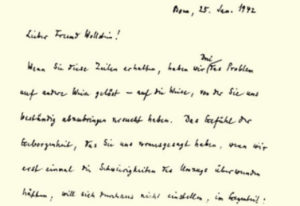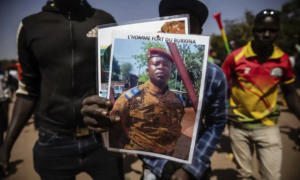A little more than a week before the jury delivered its verdict in the trial of former Minneapolis police Officer Derek Chauvin for the murder of George Floyd, and about 10 miles from the Hennepin County Government Center where Chauvin sat on trial, 20-year-old Daunte Wright was fatally shot by an officer during a traffic stop. That week, a “Thin Blue Line” flag was raised defiantly above the Brooklyn Center Police Department building in Minnesota.
The Thin Blue Line flag dates back only to 2014.
Its hoisting marked the end of a night of violently suppressed protests of the killing of the 20-year-old, a young Black father who had been pulled over, his mother said, because police had seen air fresheners dangling from his rearview mirror and had been shot in the chest by veteran Officer Kim Potter, former president of the city’s police union.
The Thin Blue Line flag dates back only to 2014. It’s the brainchild of a white college studentfrom an affluent suburb of Detroit, Andrew Jacob, who found the outcry against police violence following the killings of Tamir Rice in Cleveland, Eric Garner in New York and Michael Brown in Ferguson, Missouri, distasteful. The protests, he felt, lacked reverence for the police and were awash in animus against them.

How police put George Floyd’s killer behind bars – but the ‘blue wall’ holds
The phrase “the thin blue line” is older, perhaps first popularized in 1922 by New York City police Commissioner Richard Enright, who used the phrase to describe police as “that intensive battle line, the first line of defense against criminality.”
By the 1980s, the phrase had gone fully mainstream, propped up by a symbiotic relationship between increasingly powerful urban police departments and sympathetic media; in Errol Morris’ 1988 film of the same name, a judge told the camera that police were “the thin blue line that separates the public from anarchy.”
The flag, which has gone on to earn its creator’s company, Thin Blue Line USA, a healthy living selling related merchandise, literalizes this vision: a U.S. flag in a stark photonegative scheme, save for a broad line of blue. According to Jacob, the blue line both divides and saves: It separates the black stripes representing civilians above it from the black stripes below it, which represent criminals, a distinct category from people worthy of protection. The blue line is both a border and an elevation, hanging above the threat that needs to be eliminated.
By the morning, protesters with signs and chants had dispersed, leaving the Thin Blue Line flag to fly alone in a hazy sky.
When the April 11 death of Wright prompted renewed civilian protests in Minneapolis, police gathered — as they have gathered so many times this year, as they had in response to Floyd’s murder nearly a year ago — in tight formation, in full riot gear with shields and batons and service weapons, ready to repel an invading army.
Curfews were imposed. The National Guard was brought in. The streets were filled with the opaque greenish mist of chemical weaponry, hanging in stinging clouds that made residents in neighboring apartments cough. By the morning, protesters with signs and chants had dispersed, leaving the Thin Blue Line flag to fly alone in a hazy sky.
As the country prepared to hear the verdict in the Chauvin trial, more police armies massed in American cities. The National Guard were deployed to Minneapolis, Chicago and Philadelphia. The Los Angeles Police Department prepared en masse for protest, should Chauvin be acquitted, as did their colleagues in the New York Police Department across the country.

Chauvin verdict forces national conversation on police reform
One man’s prison sentence for a murder seen by millions on camera is a long way from the transformation we need.
Across the U.S., a militarized police force and the National Guard prepared to do what they had done so often in the face of ongoing uprisings against police violence: They prepared to brutalize their critics with every weapon they had.
In the end, of course, Chauvin was found guilty on all three of his charges. The LAPD was left to rack up overtime in “an abundance of caution.” The NYPD tailed protesters fruitlessly across bridges and through parks. The night was solemn; speakers at marches coast to coast acknowledged the heavy toll a single rare verdict of a police officer found guilty of murder had taken. Optimistic takes began to roll out: The world was changing, policing reforming.

Police killings of Black Americans continue apace in wake of Chauvin verdict
But one man’s prison sentence for a murder seen by millions on camera is a long way from the transformation we need. A year of protest against police violence, and brutal counterprotest by the police in the name of public order, had reportedly little impact on a system of policing built around a core of violence. In fact, police violence by Minneapolis law enforcement “increased substantially” following the 2020 murder of Floyd.https://platform.twitter.com/embed/Tweet.html?creatorScreenName=MSNBC&dnt=false&embedId=twitter-widget-0&features=eyJ0ZndfZXhwZXJpbWVudHNfY29va2llX2V4cGlyYXRpb24iOnsiYnVja2V0IjoxMjA5NjAwLCJ2ZXJzaW9uIjpudWxsfSwidGZ3X2hvcml6b25fdHdlZXRfZW1iZWRfOTU1NSI6eyJidWNrZXQiOiJodGUiLCJ2ZXJzaW9uIjpudWxsfX0%3D&frame=false&hideCard=false&hideThread=false&id=1384617793497165832&lang=en&origin=https%3A%2F%2Fwww.msnbc.com%2Fopinion%2Fbehind-thin-blue-line-flag-america-s-history-police-violence-n1264866&sessionId=4bed994a0b604f2c3678e51a3444db836e0c3eb2&siteScreenName=MSNBC&theme=light&widgetsVersion=82e1070%3A1619632193066&width=550px
The current cycle of protests is a grotesque and familiar protocol, shaped over the past years since the killing of Michael Brown in 2014.
The police kill a man or a woman; or a teenage girl, in the case of 16-year-old Ma’Khia Bryant, who was fatally shot by an officer near her home in Columbus, Ohio, shortly before the Chauvin verdict was delivered; or a child, as in the case of 13-year-old Adam Toledo, shot with his hands up in Chicago last month.

Ohio State students hold protest for Ma’Khia Bryant
Agitated at the news that yet another armed agent of the state has killed a member of the public, protesters object. They are met by massed and prepared force. The force is organized with military precision and often military equipment. Its chemical weapons are banned from theaters of war but available for promiscuous use among the populace. “Less-lethal” munitions, which can blind and mutilate, stutter through the nighttime streets. In a protest against police violence, police are counterprotesters, and it is first and foremost the police who riot, engaging in orgies of violence against their perceived enemies.
The writer Patrick Wyman has hypothesized that the flagrancy of police violence against protesters is part of a strategy of “exemplary violence,” akin to the outsize and grotesque revenges inflicted on participants in medieval peasants’ rebellions.
“Rather than thinking that they ought to be chastened by being caught on tape beating, tear-gassing, and pepper-spraying protesters, perhaps doing all this in full view of the public is the point,” Wyman wrote in a column addressing the war scenes in American streets surrounding the initial wave of Floyd protests. “They’re not afraid of being filmed, because being filmed simply reinforces the central theme: If you come to protest, an action that explicitly challenges the order and my place in it, this is the consequence. Expect more of it.”
Studies have shown that police don’t solve most violent crimes.
Demands for change in American policing have outstripped the 2010s ethos of “reform,” which for years involved providing more and more resources to bloated police departments: for training that has proved ineffective, body cameras that can and do serve as aids in crafting meretricious narratives, for consent decrees in cities with particularly egregious police regimes that wind up protecting departments more than curbing their atrocities.
Studies have shown that police don’t solve most violent crimes: Roughly 40 percent of homicide investigations do not result in arrests, and only 33 percent of rape investigations end in an arrest. Property crime investigations altogether have an abysmal 17 percent clearance rate.
Nonetheless, the police continue to operate under layers of legal impunity and institutional protection that vastly overshadow the rights of the citizens they brutalize, murder or assault.

A Chauvin guilty verdict doesn’t mean the system is working
They are protected by “law enforcement officers’ bill of rights” laws in more than a dozen states, which cushion them from the legal fallout of felonies and abuses; by the egregious doctrine of qualified immunity, which shields them from lawsuits against constitutional rights violations; by unions that embrace without qualification the worst offenders in police forces and exercise considerable power over municipal governments with both flush finances and the implicit threat of a heavily armed and punitive membership. Their mentality is flag-draped, all noblesse oblige and wounded besiegement, but their actions are those of armies accountable only to their own leadership.
They operate as islands, their derision for the populace they purportedly protect on full display. Furor in the streets has given way to tense negotiations over municipal budgets, but despite a few modest efforts to curb police budgets and reassign nonviolent duties to other city departments, the overall dynamic, across a country riven by state violence, has remained largely static.
It goes like this: Police kill a person. They release a curt statement in grammar designed to deflect responsibility (“officer-involved shooting”; “incident”). The dead person is a “suspect” before they are a man, woman or child. Those who object are subject to exemplary violence. The streets fill with bodies and stinging, painful clouds. The flag of the Thin Blue Line rises and rises. News of another police killing hits before the grieving family has concluded their press conference, and the cycle begins again, until it breaks, or we do.




